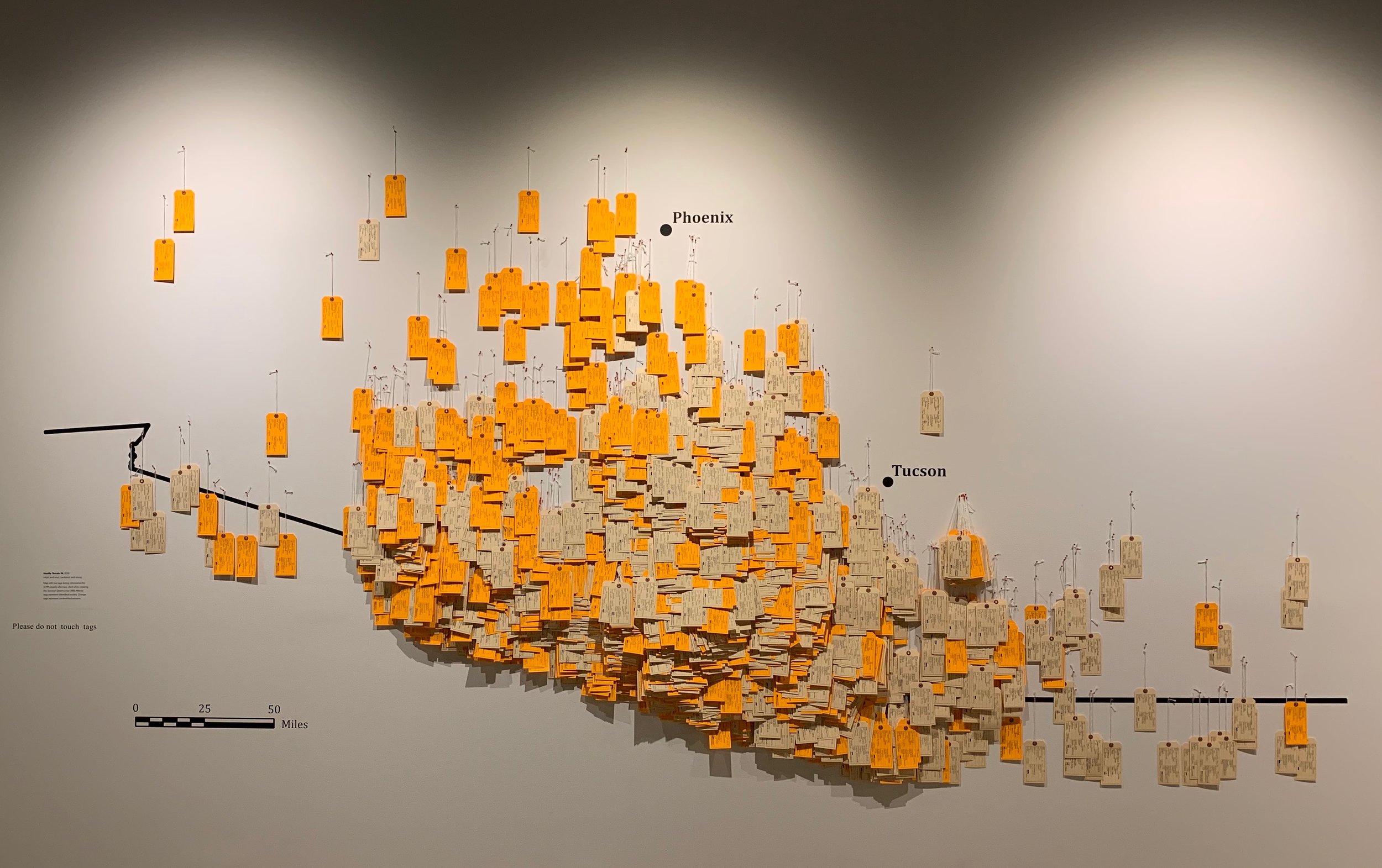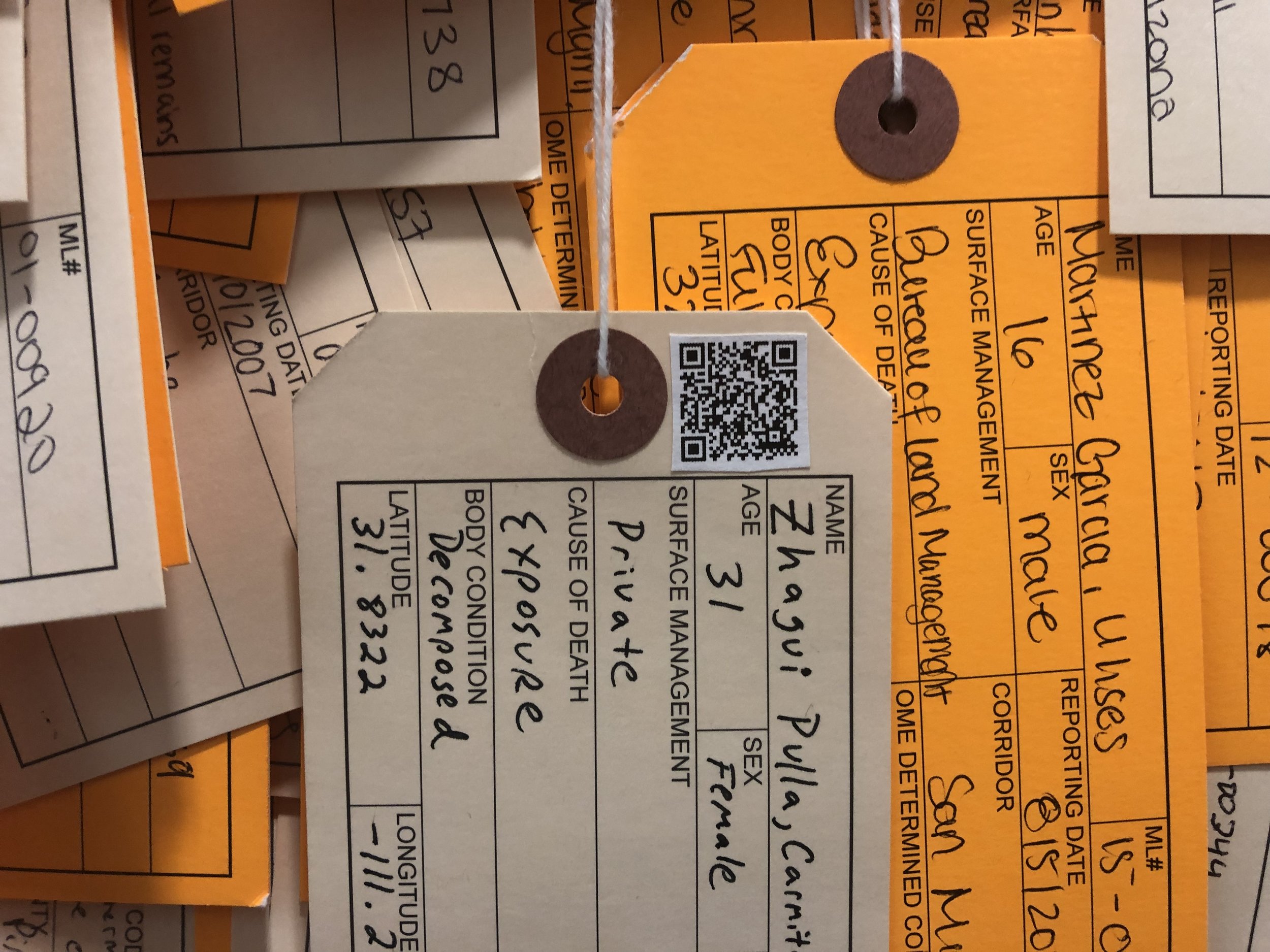POP-UP INSTALLATION SYNOPSIS
Figure 1. Toe Tag Wall Prototype (Phillips Museum of Art, Franklin & Marshall College)
The Installation
Hostile Terrain 94 is an ongoing exhibition that has been installed in over 100 locations around the world since 2019. These installations are a 16-20 foot long map of the Arizona/Mexico border with ~4200 hand written toe tags. These tags represent the recovered bodies of people who have died between 2000 and 2024 crossing the US/Mexico border through the Sonoran Desert (Figure 1). These tags are color coded (manila for identified bodies and orange for the approximately 1,300 unidentified) (Figures 2-4) and are filled out by teams of volunteers who place them in the exact locations on the map where those individuals were found. These tags are synched to a large grid to ensure accurate placement of individual remains. Each map comes with introductory wall text explaining the project and also feature an augmented reality (AR) experience to accompany the map that can be accessed for free using a cell phone app.
Figure 2. Detail of Toe Tag Wall (Phillips Museum of Art, Franklin & Marshall College)
Figure 3. Detail of Toe Tag Wall and AR component (University of Michigan)
INTERPRETATIVE GOALS
This installation is intended to do several things:
To raise awareness during a presidential election season about the realities of the U.S./Mexico border including the death and suffering that has been happening daily (since Clinton Administration) as a direct result of the Border Patrol policy known as “Prevention Through Deterrence” (PTD).
To globally memorialize the thousands who have died as a result of PTD, especially the hundreds of still unidentified people whose remains have yet to be reunited family members.
To construct an affordable, accessible, and democratized exhibition that draws in community participation across a range of national and international locations. The installation logistics require the involvement of many people who will directly contribute to its construction and display. The most powerful participatory element of this project involves the time and effort required of volunteers to meticulously fill out the ~4200 individual toe tag cards that include the name, age, sex, cause of death, condition of body, and location of recovery for each person (Figure 5).
In addition to making the installation using a team of volunteers, each host location (in consultation with the UMP) will create locally relevant programming to coincide with the event (e.g., lectures, testimonials, vigils, performances, film screenings, etc.) that connects that community to global and local immigration issues. This includes the development of an affordable Augmented Reality (AR) experience that can connect the viewer (via a free cell phone app) to stories and visuals from the desert. Each hosting hub will run their own social media programs the week of the install and photograph and film aspects of their installation for inclusion in a book and film to be produced by the UMP.
Figure 4. Detail of Toe Tag Wall (Phillips Museum of Art, Franklin & Marshall College)
Figure 5. Volunteers Installing the Wall (Phillips Museum of Art, Franklin & Marshall College)
INSTALLATION STRUCTURE
Collaborating community groups, institutions, and organizations receive a pre-prepared installation package complete with wall map, blank toe tags, death information, detailed installation instructions, and associated promotional materials including access to online resources. These groups will self-organize for the installation in consultation with members of the UMP, some of whom will physically travel to select sites to assist with the install (when possible). Each hosting institution will organize additional events around the installation that are appropriate and relevant to local immigration issues. These communities will live stream parts of their events, as well as make photographic and video recordings that will be compiled into a website, book, and film.
FUNDING
Funding for this project comes from a variety of sources including development and implementation grants donations from individuals and corporate sponsors, and funds from hosting institutions. The funding commitment from a host institution or group is $3500. This fee includes installation materials, shipping, and insurance.
Personnel: The Undocumented Migration Project (UMP) is an internationally known research-education-art collective founded by Jason De León in 2009. The UMP has been featured in numerous academic publications, as well as popular media outlets including The New York Times, RadioLab, and the BBC. De León is Professor of Anthropology and Chicana/o Studies at UCLA. He is the author of the award winning book “The Land of Open Graves: Living and Dying on the Migrant Trail” (UC Press 2015), co-curator of the award winning exhibition “State of Exception”, and a 2017 MacArthur Foundation Fellow. The pop-up installation “Hostile Terrain” is based on the multi-media exhibition of the same name co-produced by Michael Wells and Lucy Cahill.
INFORMATION PACKET
For additional information, please download our program description here:
SYNOPSIS: HOSTILE TERRAIN 94
References
Full references available in above information packet.




